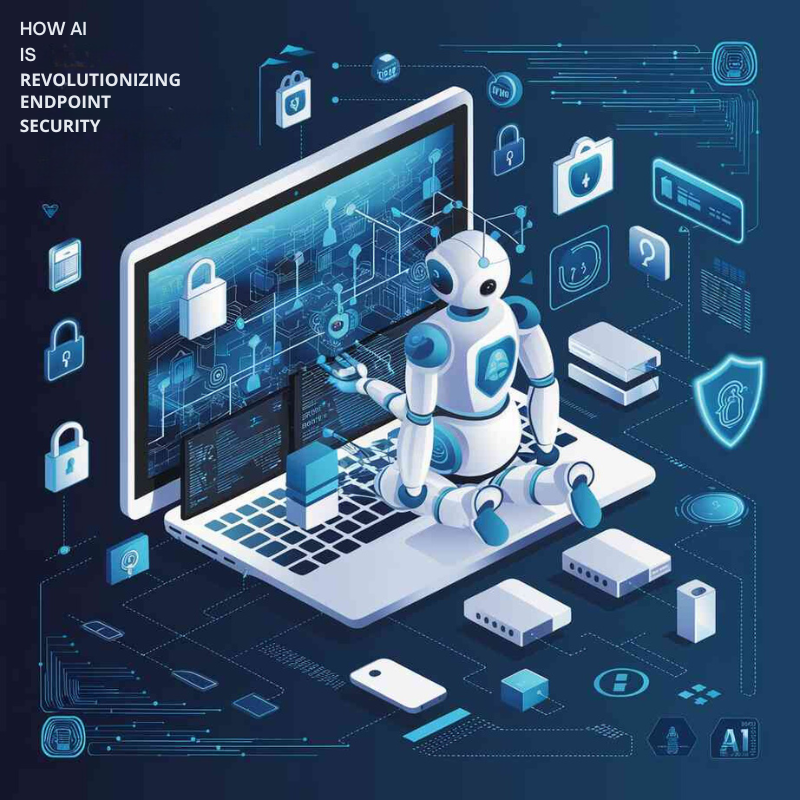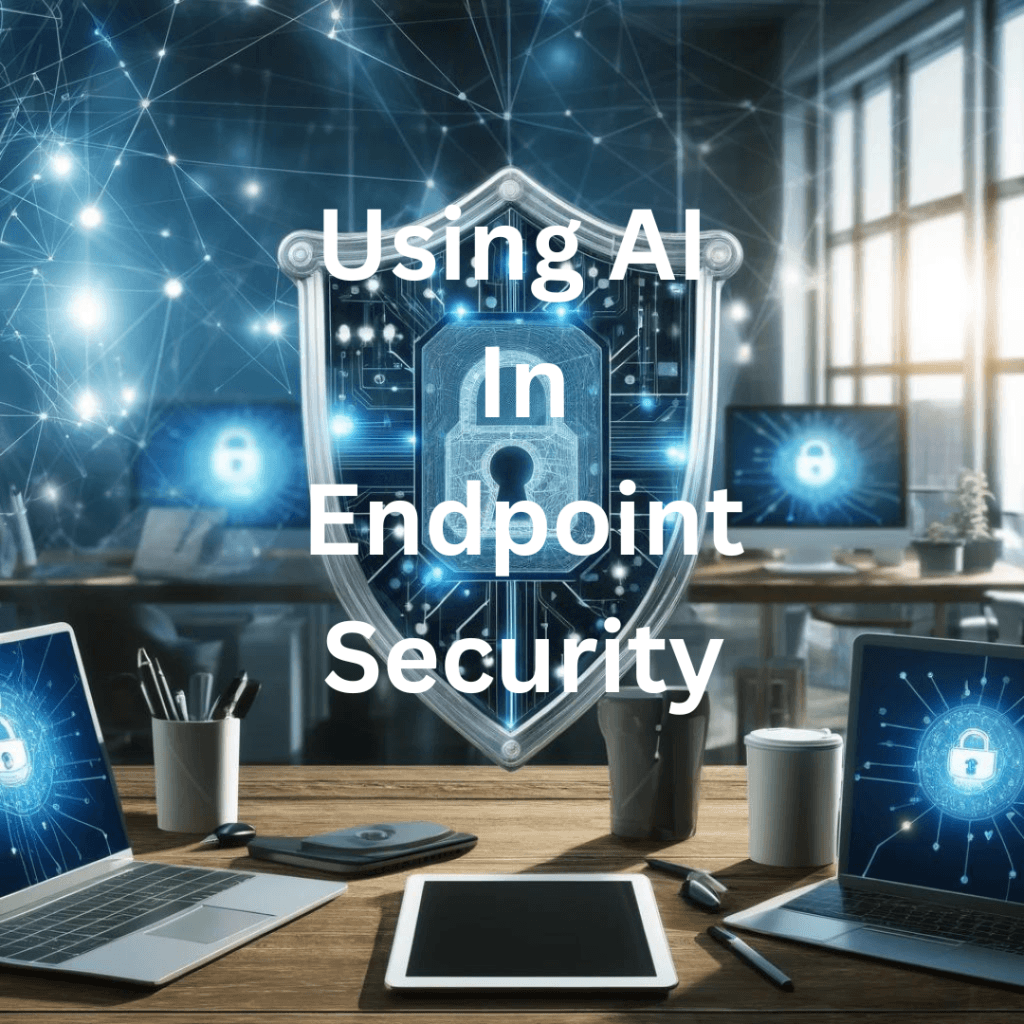Storing data securely is becoming harder. Online threats keep changing and standard security methods often can’t keep up. This is where Artificial intelligence (AI) helps, by transforming the way endpoint security works. This isn’t limited to a technology update. it’s about overhauling all defense strategies. Let’s explore how AI is revolutionizing endpoint security!

An endpoint is any device that connects to a network, like computers, smartphones, and servers. Use them as gateways to your important data. In the past, shielding these entry points was simple but with advancing threats, the old approach doesn’t work anymore. AI proves useful here by bringing in a slyer and adaptable method to endpoint security.
Key Takeaways
- Enhanced Threat Detection: AI significantly improves the detection of both known and unknown threats through advanced behavior analysis and anomaly detection.
- Faster Response Times: Automated threat response and remediation by AI lead to quicker containment and mitigation of security incidents.
- Proactive Security Measures: Predictive analytics provided by AI offer early warnings about potential future attacks, enabling proactive defense strategies.
- Continuous Learning and Adaptation: AI systems continuously learn from new data, adapting to emerging threats and improving security measures over time.
The way AI helps with cybersecurity is appealing. It’s not merely an additional tool. instead it completely changes the way we recognize and react to dangers. AI algorithms grow smarter due to their ability to learn from past experiences. They do this while pinpointing irregularities. These are unusual events that may easily be ignored by human analysts or normal software programs. Discovering AI in cyber defense is just scratching the surface of its capabilities. The more you explore endpoint security, the more you will realize how indispensable this technology has become.
Grasping the Essentials of Endpoint Security
Let’s uncover endpoint security, as cyber threats become cleverer. Imagine every device linked with your network, laptops, phones, servers these are all endpoints. Each of them could permit unauthorized entry if they are not safe.
So, what’s the risk? From personal data to intellectual property, the potential losses are enormous. Also, classic security measures aren’t enough anymore. This is why endpoint security is now vital. It’s not an optional extra. it’s a crucial line of defence and a shield again unwanted visits that guarantees regulatory compliance as well.
You’ll learn about different threats that target these weak spots. For instance, malware is common and typically slips through outdated security systems’ gaps. There’s also ransomware which hijacks data and disables organizations until a payoff is made. Additionally, phishing attacks can trick unsuspecting users into relinquishing private information.
This isn’t simply about using antivirus software and being done. It also considers bringing in an all-encompassing strategy including:
- regular updates
- proactive monitoring
- user training sessions.
In my view having strong endpoint security is like having a good goalkeeper in a football match – they are your final defense.
So when improving your protection system select something that suits you best. Do you prefer simplicity or full coverage? Reflect on this as we progress into comprehending how AI has a transformative role in reshaping cybersecurity. Although there’s plenty to digest I’m here to help lead you through every step.
AI: The Vanguard of Cybersecurity Evolution
We’re going to discuss the basics of artificial intelligence (AI) and its partner, machine learning (ML). Let’s see how they transform cybersecurity. You might have heard about AI but it’s not just a buzzword. it’s a potent tool that drastically changes the way we safeguard digital property.
In essence, AI has to do with replicating human intelligence in machines. These machines learn to act like humans and copy their behavior. Machine learning is an offshoot of AI. ML is concerned with these machines’ capability to:
- learn from data
- identify patterns
- make choices with little human oversight
This blend of AI and machine learning turns into a strong ally in spotting and tackling cyber risks.
We’re going to explore broadly how AI comes into play in cybersecurity. AI proves useful in ramping up the security standing of businesses. It does this by automating detailed procedures for identifying threats and initiating action against them. For instance, AI systems can repeatedly scrutinize huge amounts of data to pinpoint odd patterns that may be signs of a security compromise. Furthermore, machine learning mechanisms can progress over time. this implies they get more skilled at forecasting possible attacks and lowering their impact based on previous events.
Now let’s examine how AI specifically sharpens endpoint security devices. Transitioning into the following section promises smooth sailing. We will wade through the territory of endpoint security tools powered by AI. Then we study how they turn ordinary practices into dynamic smart prevention techniques.
How AI is Revolutionizing Endpoint Security

Let’s examine how AI has significantly reshaped endpoint security solutions. This is beyond virus scans. It’s a state-of-the-art technology that discerns normality from abnormal. Thus, guaranteeing top-notch protection against known and unknown threats.
You learn how AI recognizes unusual patterns via behavior analysis. Picture a security guard who not only remembers every employee’s face but also their daily routines. In a similar way, AI learns user behaviors. Then it can sound an alert when things appear odd. This makes it highly effective in combating zero-day attacks and advanced persistent threats.
Next, let’s look at predictive analytics. Think of it as a forecaster in cybersecurity. By examining heaps of data, AI spots trends, providing companies with early warnings on possible future attacks. This approach prepares businesses for future threats while reducing the response time considerably.
AI really excels in automated threat response and remediation. To me it’s akin to having an immediate responsive force ready at any time. AI-powered systems can spot a breach and rapidly respond by:
- containing the threat
- initiating repairs
- learning from the circumstances to block similar incidents down the line
No need to worry over the initial arrangements as you can finetune your plan eventually. The optimal solution today may require adjustments as threats change over time. That’s the charm of AI its incredible adaptability Choose something that matches your needs.
Reaping the Benefits of AI-Enhanced Security
You’re going to find out about the sweeping changes AI is making in cybersecurity. It’s not just about cool tech – AI is shifting the entire paradigm of endpoint security. Here’s how.
AI reshapes detection paradigms with a precision that far surpasses traditional methods. It’s like having a detective with superhuman powers on your team, picking up on the subtlest hints of a security breach.
Speed is of the essence when mitigating cyber threats. AI significantly accelerates incident response times. Your security system goes from reactive to proactive. It can nip potential threats in the bud before they bloom into full-scale problems.
False positives can be a real headache in the security realm. They divert valuable resources to non-issues. AI helps in drastically reducing these, clearing the fog for security teams to focus on true threats.
And AI isn’t just about the here and now; it’s a continuous learner. The more it ‘sees,’ the smarter it gets, adapting and evolving to detect new threats with more agility.
So, AI doesn’t just add a layer of security; it dynamically transforms the landscape. But, with these advancements come new challenges. Dive right in to explore what these are.
Navigating the Complexities of AI in Endpoint Security
Advancements in AI have unquestionably propelled endpoint security forward. However, this isn’t just about harnessing power; it’s about understanding the complexities that come with it. There’s a common misconception that once AI is in place, the cybersecurity infrastructure is impregnable. That’s far from the truth. In my opinion, no matter how advanced AI gets, it’s still a tool that requires fine-tuning and savvy oversight.
The Importance of Quality Data and AI
Let’s start with the data quality conundrum. AI thrives on data – the more accurate and comprehensive, the better. But what if your data is flawed? The old adage ‘garbage in, garbage out’ is fitting here. If AI systems are trained on poor-quality data, their predictions, and subsequently their actions, could be severely compromised. I’m here to help you understand that ensuring the integrity of data is just as important as implementing AI solutions themselves.
Now, consider the potential for adversarial attacks. These are instances where attackers specifically design inputs to fool AI systems, leading to incorrect predictions or classifications. It’s a sophisticated cat-and-mouse game. But don’t worry too much about it; while it’s an issue, it’s one that’s on the radar of the best minds in cybersecurity. Solutions are constantly being developed.
Lastly, we must acknowledge the ethical and privacy concerns with employing AI. There’s a lot of opportunity for AI to do good, but I believe that we must tread the line between security and privacy carefully. With AI’s ability to analyze vast amounts of data, comes the responsibility to protect personal information from misuse. Choose something that resonates with ethical values and upholds privacy standards, ensuring that AI security solutions don’t cross the threshold into invasive territory.
Ethics, Privacy and AI
Moving into the future, AI will continue to be a cornerstone in endpoint security. I’m going to cover the anticipated advancements in AI technologies next, which will further shape this field. And, yes, you can always adjust your approach down the road. However, having foundational knowledge about these advancements will help you. With that knowledge, you can adapt your cybersecurity strategies effectively and responsibly.
Peering into the Future: AI’s Continued Security Evolution
Anticipating the future trends in AI can be thrilling. Hopefully, what you’ve learned from AI’s contribution to endpoint security has been engaging. It promises to bring radical changes to the field not just minor tweaks. We are on the brink of a groundbreaking shift.
In AI’s fast paced world, new studies suggest more advanced machine learning models. These models accurately analyze huge data sets, and their ability to spot threats surpasses human skills. But it doesn’t just stop with finding more risks. it also intends to develop a near human understanding.
Collaboration is essential because AI security programs don’t operate alone. They play an active role in an overarching cyber defense scheme. This will likely involve smooth integration into pre-established systems. These platforms, such as Security Information and Event Management (SIEM) platforms and Security Orchestration, Automation, and Response (SOAR) platforms will strengthen overall cybersecurity stances.
The area of proactive threat hunting holds vast opportunities. The focus of AI isn’t limited to reacting. It aspires to predict risks too. The aim is to spot and control hazards before they grow into active threats. By combining AI with consistent threat intelligence, cybersecurity teams can develop advanced defense plans that sense patterns indicating potential future attacks.
Progress doesn’t happen in isolation. There are driving forces behind these better security needs. For instance, as cyber threats get increasingly complicated. With Internet of Things (IoT) and 5G coming up, the endpoints are surging along with possible gateways for attackers. With this rise in networks, the role of AI in controlling and securing these networks is more crucial than ever.
Embracing the AI-Driven Security Landscape
I’m going to wrap up our exploration of AI in endpoint security by revisiting some key takeaways. AI isn’t just reshaping how we protect our endpoints; it’s redefining the battleground against cyber threats.
Enhanced detection rates, swift response times, and a smart reduction in false positives are just the beginning. AI’ has the capacity for continuous learning. It has the potential to adapt to ever-evolving threats. These position it as an indispensable ally in cybersecurity.
Do you want to protect your business against the sophisticated cyber threats of today and tomorrow? Then staying abreast of AI developments is crucial. AI’s integration with cybersecurity is no longer a futuristic concept—it’s the present and the future of endpoint security.
Choose solutions that resonate with you today, knowing you can always adjust your approach down the road. Investing in AI-powered security tools is more than a strategic move. It’s also a commitment to the safety and resilience of your enterprise.
So my question to you today is, are you ready to take the necessary steps to ensure that your cybersecurity measures are robust and future-proof? By embracing AI-driven security solutions, you’re not just upgrading your defenses; you’re also embracing innovation that can propel your business forward in an increasingly connected world.
Frequently Asked Questions
What is AI’s role in endpoint security?
AI enhances endpoint security by using machine learning to detect and respond to threats faster and more accurately than traditional methods.
How does AI improve threat detection?
AI uses behavior analysis and anomaly detection to identify both known and unknown threats, ensuring comprehensive protection.
What benefits does AI offer in threat response?
AI automates threat response, reducing response times and quickly containing and mitigating security incidents.
How does AI provide proactive security measures?
AI utilizes predictive analytics to offer early warnings about potential attacks, allowing for proactive defense strategies.
Can AI adapt to new threats over time?
. Can AI adapt to new threats over time?
What are the challenges of implementing AI in endpoint security?
Challenges include ensuring data quality, mitigating adversarial attacks, and balancing ethical and privacy concerns with effective security measures.

Experienced cybersecurity analyst, software engineer, patent attorney, worked with Linux, Windows, AWS, lots of security tools. Hope to help people do the right things and do the things right!


